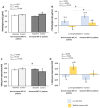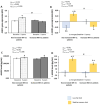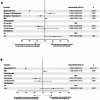Modulation of circulating levels of advanced glycation end products and its impact on intima-media thickness of both common carotid arteries: CORDIOPREV randomised controlled trial
- PMID: 39402581
- PMCID: PMC11475769
- DOI: 10.1186/s12933-024-02451-4
Modulation of circulating levels of advanced glycation end products and its impact on intima-media thickness of both common carotid arteries: CORDIOPREV randomised controlled trial
Abstract
Background: Increasing evidence supports the role of advanced glycation end products (AGEs) in atherosclerosis in both diabetic and non-diabetic patients, suggesting that therapeutic strategies targeting AGEs may offer potential benefits in this population. The Mediterranean diet is associated with improved biomarkers and anthropometric measurements related with atherosclerosis in addition to its ability to modulate AGE metabolism. Our aim was to determine whether the reduction in atherosclerosis progression (measured by changes in intima-media thickness of both common carotid arteries (IMT-CC)), observed after consumption of a Mediterranean diet compared to a low-fat diet, is associated with a modulation of circulating AGE levels in patients with coronary heart disease (CHD).
Methods: 1002 CHD patients were divided in: (1) Non-increased IMT-CC patients, whose IMT-CC was reduced or not changed after dietary intervention and (2) Increased IMT-CC patients, whose IMT-CC was increased after dietary intervention. Serum AGE levels (methylglyoxal-MG and Nε-Carboxymethyllysine-CML) and parameters related to AGE metabolism (AGER1 and GloxI mRNA and sRAGE levels) and reduced glutathione (GSH) levels were measured before and after 5-years of dietary intervention.
Results: The Mediterranean diet did not affect MG levels, whereas the low-fat diet significantly increased them compared to baseline (p = 0.029), leading to lower MG levels following the Mediterranean diet than the low-fat diet (p < 0.001). The Mediterranean diet, but not the low-fat diet, produced an upregulation of AGE metabolism, with increased AGER1 and GloxI gene expression as well as increased GSH and sRAGE levels in Non-increased IMT-CC patients (all p < 0.05). Although the Mediterranean diet increased MG levels in Increased IMT-CC patients, this increment was lower compared to the low-fat diet (all p < 0.05).
Conclusions: Our results suggest that an improvement in modulation of AGE metabolism, which facilitates better management of circulating AGE levels, may be one of the mechanisms through which the Mediterranean diet, compared to a low-fat diet, reduces the progression of atherosclerosis in patients with CHD. Trial registration https://clinicaltrials.gov/ct2/show/NCT00924937 , Clinicaltrials.gov number, NCT00924937.
Keywords: Advanced glycation end products; Atherosclerosis; Dietary intervention; Mediterranean diet.
© 2024. The Author(s).
Conflict of interest statement
The authors declare that they have no known competing financial interests or personal relationships that could have appeared to influence the work reported in this paper.
Figures





Similar articles
-
Dietary modulation of advanced glycation end products metabolism on carotid intima-media thickness in type 2 diabetes patients: From the CORDIOPREV study.Clin Investig Arterioscler. 2023 May-Jun;35(3):105-114. doi: 10.1016/j.arteri.2022.08.004. Epub 2022 Sep 29. Clin Investig Arterioscler. 2023. PMID: 36184301 Clinical Trial. English, Spanish.
-
Mediterranean Diet Reduces Atherosclerosis Progression in Coronary Heart Disease: An Analysis of the CORDIOPREV Randomized Controlled Trial.Stroke. 2021 Nov;52(11):3440-3449. doi: 10.1161/STROKEAHA.120.033214. Epub 2021 Aug 10. Stroke. 2021. PMID: 34372670 Clinical Trial.
-
Dietary antioxidant intake reduces carotid intima-media thickness in coronary heart disease patients: From the CORDIOPREV study.Free Radic Biol Med. 2024 Jan;210:221-229. doi: 10.1016/j.freeradbiomed.2023.11.026. Epub 2023 Nov 29. Free Radic Biol Med. 2024. PMID: 38036071
-
Does dietary fat affect advanced glycation end products and their receptors? A systematic review of clinical trials.Nutr Rev. 2022 Feb 10;80(3):598-612. doi: 10.1093/nutrit/nuab095. Nutr Rev. 2022. PMID: 34871448
-
Dietary glycation compounds - implications for human health.Crit Rev Toxicol. 2024 Sep;54(8):485-617. doi: 10.1080/10408444.2024.2362985. Epub 2024 Aug 16. Crit Rev Toxicol. 2024. PMID: 39150724
Cited by
-
Association Between Skin Autofluorescence and Coronary Heart Disease in Chinese General Population: A Cross-Sectional Study.J Diabetes. 2025 Mar;17(3):e70061. doi: 10.1111/1753-0407.70061. J Diabetes. 2025. PMID: 40024885 Free PMC article.
-
The Advanced Glycation End-Products (AGE)-Receptor for AGE System (RAGE): An Inflammatory Pathway Linking Obesity and Cardiovascular Diseases.Int J Mol Sci. 2025 Apr 14;26(8):3707. doi: 10.3390/ijms26083707. Int J Mol Sci. 2025. PMID: 40332316 Free PMC article. Review.
References
-
- Hess CN, Clare RM, Neely ML, Tricoci P, Mahaffey KW, James SK, Alexander JH, Held C, Lopes RD, Fox KAA, et al. Differential occurrence, profile, and impact of first recurrent cardiovascular events after an acute coronary syndrome. Am Heart J. 2017;187:194–203. - PubMed
-
- Piepoli MF, Corra U, Dendale P, Frederix I, Prescott E, Schmid JP, Cupples M, Deaton C, Doherty P, Giannuzzi P, et al. Challenges in secondary prevention after acute myocardial infarction: a call for action. Eur Heart J Acute Cardiovasc Care. 2017;6(4):299–310. - PubMed
-
- Greenland P, Knoll MD, Stamler J, Neaton JD, Dyer AR, Garside DB, Wilson PW. Major risk factors as antecedents of fatal and nonfatal coronary heart disease events. JAMA. 2003;290(7):891–7. - PubMed
-
- Writing Group M, Mozaffarian D, Benjamin EJ, Go AS, Arnett DK, Blaha MJ, Cushman M, Das SR, de Ferranti S, Despres JP, et al. Heart Disease and Stroke Statistics-2016 update: a Report from the American Heart Association. Circulation. 2016;133(4):e38–360. - PubMed
Publication types
MeSH terms
Substances
Associated data
Grants and funding
LinkOut - more resources
Full Text Sources
Medical
Research Materials
Miscellaneous

